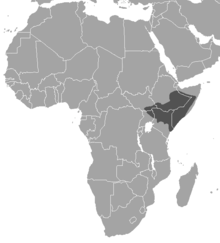Species of mammal
| Günther's dik-dik |
 |
| Günther's dik-dik at Samburu National Reserve, Kenya |
Conservation status |
 Least Concern (IUCN 3.1)[1] |
Scientific classification  |
| Domain: | Eukaryota |
| Kingdom: | Animalia |
| Phylum: | Chordata |
| Class: | Mammalia |
| Order: | Artiodactyla |
| Family: | Bovidae |
| Subfamily: | Antilopinae |
| Genus: | Madoqua |
| Species: | M. guentheri |
| Binomial name |
Madoqua guentheri
|
 |
| The range of Günther's dik-dik |
Günther's dik-dik (Madoqua guentheri) is a small antelope found in arid zones of East Africa.
Description
Günther's dik-dik is one of the smallest ungulates in Africa, weighing 3–5 kilograms (6.6–11.0 lb) when fully grown. It has a yellowish-gray to reddish-brown coat, black hooves, small heads with long necks and large ears with white insides. Belly, chin, breast, throat and inner thighs are cream or white. The tail is short (~3–5 cm). Males are horned, with horn length (~9.8 cm) varying between individuals. Although the horn cores are only present in males, gender identification can be difficult from a distance. Females are larger and lack horns.[3]
Four subspecies have been proposed based on size and pelage features, but have not yet been analyzed genetically.[1]
Distribution and habitat
The species is found in the lowlands of Ethiopia, most of the northern and eastern regions of Kenya, Somalia excluding specific regions of the coast, limited regions of southeastern Sudan, and northeastern Uganda.[1][3] They avoid coastal regions. Typical habitat includes low thicket-type vegetation in thornbush, savanna grassland and riverine woodland biomes, and extends to disturbed and overgrazed areas. Habitat overlaps with other small antelope species such as Kirk's dik-dik.[3]
Ecology
Günther's dik-dik is a browser rather than a grazer, feeding mainly on the leaves, flowers, stems, fruits and seeds of non-grasses. The species feeds on plants close to the ground, due to its small stature. It is primarily diurnal, with activity peaks from dawn until mid-morning and mid-afternoon until after dark.[4] The species is monogamous; parents and calves do not form family groups for prolonged periods, and the calf is driven out at an early age to fend for itself.[3] Only a single calf is born at a time. The species does not breed seasonally and can have late gestation periods.[5]
While it has a limited vocal repertoire, the species has been shown to make use of the alarm calls of other species, for example responding with increased vigilance or flight behaviour to the alarm calls of the white-bellied go-away-bird.[6]
Conservation
The species is classified as Least Concern by the IUCN, as it appears to be common throughout its range. Total population size is estimated as at least 500,000 individuals. It is hunted for meat, but not commercially.[1] Habituation to human presence may have a negative fitness effect on individuals, but this has not yet been verified.[7]
References
- ^ a b c d IUCN SSC Antelope Specialist Group (2016). "Madoqua guentheri". IUCN Red List of Threatened Species. 2016: e.T12669A50190613. doi:10.2305/IUCN.UK.2016-1.RLTS.T12669A50190613.en. Retrieved 19 November 2021.
- ^ Thomas, Oldfield (1894). "On the Dwarf Antelopes of the Genus Madoqua". Proceedings of the Zoological Society of London. 62: 323–329. doi:10.1111/j.1469-7998.1894.tb00575.x.
- ^ a b c d Kingswood, S.J.; Kumamoto, A.T. (1996). "Madoqua guentheri" (PDF). Mammalian Species (539): 1–10. doi:10.2307/3504145. JSTOR 3504145. Archived from the original (PDF) on 2016-03-16. Retrieved 2016-11-18.
- ^ Ford, Adam; Goheen, J. A. (24 June 2015). "An experimental study on risk effects in a dwarf antelope, Madoqua guentheri". Journal of Mammalogy. gyv090 (5): 2–5. doi:10.1093/jmammal/gyv090.
- ^ Robeck, Todd; Fitzgerald, Lisa J.; Hnida, John; Turczynski, Craig; Smith, Dee; Kraemer, Duane C. (1997). "Analysis of urinary progesterone metabolites with behavioral correlation in Guenther's dik-dik". Journal of Zoo and Wildlife Medicine. 28 (4): 2–9. JSTOR 20095687.
- ^ Lea, A. J.; Barrera, J. P.; Tom, L. M.; Blumstein, D. T. (2008). "Heterospecific eavesdropping in a nonsocial species". Behavioral Ecology. 19 (5): 1041–1046. CiteSeerX 10.1.1.486.8170. doi:10.1093/beheco/arn064.
- ^ Coleman, Andrea; Richardson, Dominique; Schechter, Robin; Blumstein, Daniel T. (2008). "Does habituation to humans influence predator discrimination in Guenther's dik-diks (Madoqua guentheri)?". Biology Letters. 4 (3): 1–3. doi:10.1098/rsbl.2008.0078. PMC 2610055. PMID 18381260.
Taxon identifiers |
|---|
| Madoqua guentheri | |
|---|















